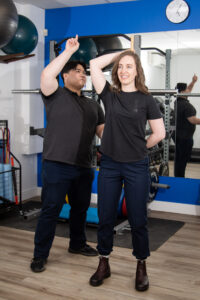While it can seem intimidating at first, running is a fantastic way to stay fit, improve your mood and spend time outdoors. With spring just around the corner, the cold days of the Okanagan winter are coming to an end, and the promise of warmer spring weather makes the thought of jogging on the KVR a joy.
While this all sounds very idyllic, newer runners, or those who are returning to running after having a winter break, can often find themselves injured, fatigued and disheartened when the going is a little harder than they thought it would be when they first started their new hobby, and may even be forced to stop running. While unfortunately this undoubtedly happens, with a little preparation and help from the right people, you can leave your aforementioned problems in the dust and meet your running goals. Read on to learn 4 tips that new and returning runners shouldn’t miss!
1 – Don’t overdo it when you start
I get it; you’ve started running, and now you want to do a Forest Gump and just keep going. While this may sound like a good idea at the time, it unfortunately is a great way to get injured and burnt out. Running is a very physically demanding sport, both physically and metabolically, and it can place a lot of strain on your body.
Our bodies all have the capacity to increase the distance we can run, but they have to first adapt to running to realize this capacity. What this means is that we need to gradually increase the distance and duration we are running to avoid injury and burnout.
Almost all running injuries arise from increasing how much you are running too quickly (this also applies for experienced and even professional runners – if they take a few months off running and then return to their pre-break distances, they have a high chance of getting injured). If you build up gradually, you are much less likely to become injured, and your body will adapt to the activity better.

2- Create a training plan – and stick to it
Like most aspects of life, if you have a plan for something, it generally will go better. Running is no different. There is an almost infinite amount of running training plans out there, and it is easy to get lost in the mix.
Generally speaking, pick one plan and stick with it. For totally novice runners, the run-walk method may work well for you – run for 10-30 seconds, and then walk for 1-2 minutes for the duration of your run. If that is too easy, try running for 1-5 minutes, and then walk for 1-2 minutes – you can increase the time running as you progress, but you always will walk for short periods at set intervals to give your body a rest. This technique can be used all the way through to running marathons!!
3- Cross training is great for runners
The typical runners mentality is to run, run and run. I can put my hand up to falling into this trap. Unfortunately, if you only run and don’t do any other kind of cross training, you are more likely to become injured and you may not develop the strength in your legs and core to help reach your running goals.
If you are on a running plan, try and make one of your weekly work outs a cross-training session – this could be riding a bike, going for a swim, or having a gym workout. By doing so, you will be giving your body a break from the constant impact it has to endure during running, while helping to improve your cardio and strength. Doing a weekly leg-workout will help you to both improve your running ability, but help reduce the chance of getting injured.

4 – Get a running assessment
The way that you run, otherwise known as your running form, is one of the most important things to consider for both new and experienced runners. This is because an improper running form can lead to you wasting energy, increasing the impact to your knees and hips, and having a higher chance of injuring yourself.
All of our therapists are able to help you improve your running, and help alleviate any aches and pains you may be experiencing during your runs. On top of this, our physiotherapist Chris completes running specific assessment and treatment plans, which include checking the strength and flexibility of your legs, as well as watching your running form while you run on a treadmill. Our therapists are also able to advise you about other aspects of your running, such as advice on appropriate footwear, and provide hands-on treatment, as needed.
The good news is that often, with a few tweaks to your running form, a handful of specific exercises and perhaps a few sessions of IMS, we are often able to help resolve the running issues our patients are experiencing.
If you are interested in being able to run further and in a pain free manner, click here to book in with one of our physiotherapists, or for the running specific physiotherapy appointment, book online with our physio Chris.






